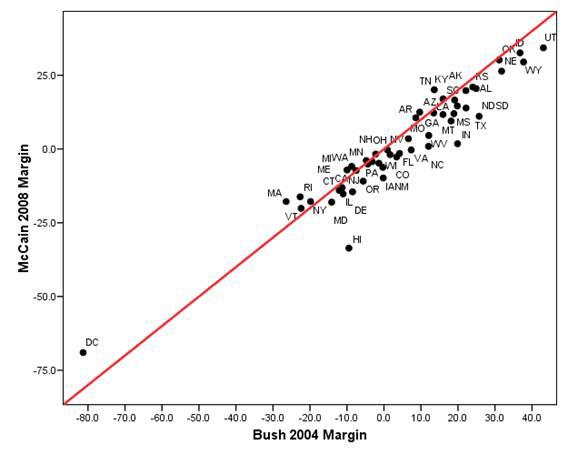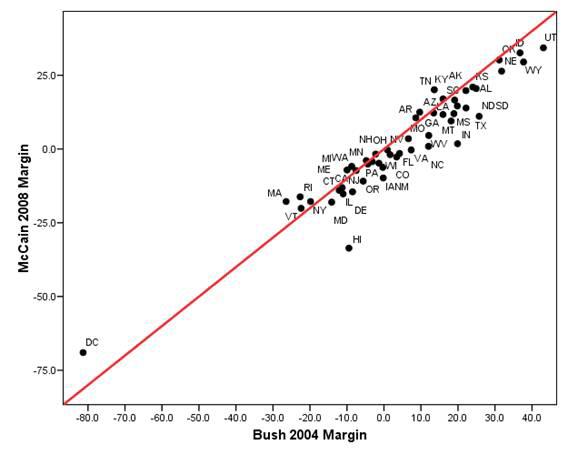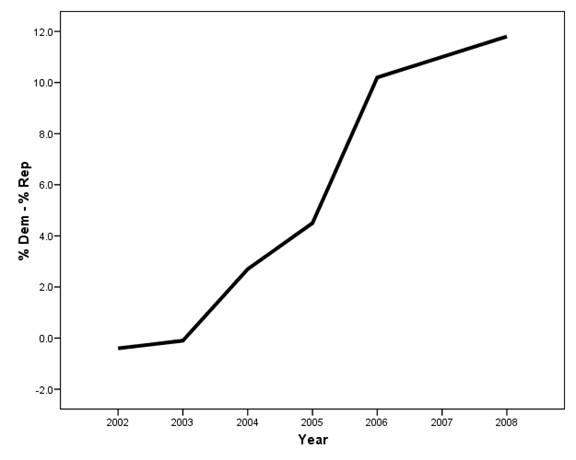Thirty Days and Counting
A Commentary By Alan Abramowitz
With one month remaining in the 2008 presidential campaign, national and state polling data indicate that Barack Obama holds a clear lead over John McCain. In the past sixty days, despite a series of dramatic events including the Democratic and Republican national conventions, John McCain's surprise selection of Alaska Governor Sarah Palin as his running-mate, a financial crisis on Wall Street, and the first presidential and vice-presidential debates, there has been very little change in the relative standing of the candidates.
Since clinching the Democratic nomination in early June, Obama has led McCain in the Gallup Tracking Poll for 14 out of 16 weeks while McCain has led for only one week. During the first week of September, immediately following the Republican Convention, McCain had a 2 point lead over Obama. By the second week of September, however, Obama had taken a 2 point lead and during the final two weeks of September, Obama led McCain by 4 points and 5 points respectively. That margin appears to have increased slightly during the first week of October. Obama's margin over McCain has been 5, 7, 8, and 7 points in the three-day rolling averages for October 2-5. Other recent national polls have Obama holding a similar or larger lead.
The crosstabs from the Gallup Tracking Poll in Table 1 show remarkable stability in the patterns of support for Obama and McCain between June-July and September. Obama continues to show significant improvement over John Kerry's performance in every demographic group except voters 65 years of age and older. As in the June and July polling, his largest gains over Kerry are among voters under the age of 30 (+17 points) and Hispanics (+29 points).
Table 1. Democratic Margin among Voter Groups in 2004 and 2008
|
2004 |
6/9-8/3,
|
9/22-28,
|
Change,
|
||
|
Men |
- 11 |
- 5 |
- 5 |
+ 6 |
|
|
Women |
+4 |
+ 11 |
+ 13 |
+ 9 |
|
|
18-29 |
+ 9 |
+ 23 |
+ 26 |
+ 17 |
|
|
30-49 |
- 7 |
0 |
+ 2 |
+ 9 |
|
|
50-64 |
- 5 |
+ 3 |
+ 3 |
+ 8 |
|
|
65 + |
- 5 |
- 6 |
- 4 |
+ 1 |
|
|
Whites |
- 17 |
- 11 |
- 11 |
+ 6 |
|
|
Blacks |
+ 78 |
+ 86 |
+ 84 |
+ 6 |
|
|
Hispanics |
+ 10 |
+ 33 |
+ 39 |
+ 29 |
|
|
WHITES ONLY |
|||||
|
High School |
- 21 |
- 15 |
- 14 |
+ 7 |
|
|
Some College |
- 25 |
- 15 |
- 17 |
+ 8 |
|
|
Grad College |
- 19 |
- 12 |
- 11 |
+ 8 |
|
|
Post College |
+ 2 |
+ 8 |
+ 7 |
+ 5 |
|
|
Church Weekly |
- 43 |
- 37 |
- 38 |
+ 5 |
|
|
Most Weeks |
- 24 |
- 18 |
- 19 |
+ 5 |
|
|
Seldom, Never |
+ 8 |
+ 10 |
+ 12 |
+ 4 |
|
Sources: 2004 National Exit Poll and Gallup Tracking Poll, June 9 - August 3, 2008, and September 22-28, 2008.
State polling data show that the relationship between 2008 voting intentions and the results of the 2004 presidential election is extremely strong. Figure 1 displays a scatterplot of this relationship. The correlation between the 2004 election results and the 2008 poll results is now .96. This is almost as strong as the .97 correlation between the 2000 and 2004 election results. Obama is polling best in the states that John Kerry won handily in 2004 while McCain is polling best in the states that George Bush won handily in 2004. However, the large majority of points on the graph are located below the line of equality, indicating that Obama is polling ahead of Kerry.
Figure 1. Current McCain Margin by 2004 Bush Margin
Source: Pollster.com and data compiled by author.
Obama's advantage becomes even clearer when we focus on the 15 battleground states that will decide the outcome of the presidential race. These states include the 12 swing states from 2004 (Florida, Ohio, Pennsylvania, Michigan, Florida, Colorado, New Mexico, Minnesota, Iowa, Wisconsin, Nevada, and New Hampshire) and three new states in 2008--Indiana, Virginia, and North Carolina. George Bush carried 10 of these 15 states in 2004. The scatterplot in Figure 2 shows that Barack Obama is running well ahead of John Kerry in most of these states. In fact, Obama is currently leading in 13 of these 15 states, all except North Carolina and Indiana, and recent polls show the race to be extremely close in those two states which George Bush carried by 12 and 20 points respectively in 2004.
Figure 2. McCain 2008 Margin by Bush 2004 Margin in 15 Swing States
Source: Pollster.com and data compiled by author.
Table 2 shows that here has been one significant change in the pattern of support for Obama and McCain since early August: both candidates have consolidated their support within their own parties. Obama's lead among Democrats has increased from 68 points in June and July to 76 points in late September while McCain's lead among Republicans has increased from 74 points in June and July to 80 points in late September. Thus, it appears that the major impact of the events of the past two months has been to reinforce voters' partisan predispositions.
Table 2. Democratic Margin by Party Identification in Gallup Tracking Poll
|
June 9 -
|
Sept. 22 -
|
Change |
||
|
Democrats |
+ 68 |
+ 76 |
+ 8 |
|
|
Independents |
+ 1 |
+ 2 |
+ 1 |
|
|
Republicans |
- 74 |
- 80 |
- 6 |
Sources: 2004 National Exit Poll and Gallup Tracking Poll, June 9-August 3, 2008 and September 22-September 28, 2008.
Although both candidates have improved their standing among their own party's supporters in the past two months, this trend is good news for Barack Obama because Democratic identifiers now substantially outnumber Republican identifiers in the American electorate. Figure 3 displays the trend in the Democratic advantage in party identification among eligible voters in the Gallup Poll since 2002. Over these six years the two parties have gone from near parity in voter support to a Democratic advantage of about 12 points. This is the largest Democratic advantage in party identification in the Gallup Poll since the early 1990s. While Democratic identification among actual voters is typically lower than Democratic identification among eligible voters due to higher turnout among Republicans, a double-digit advantage among eligible voters is likely to translate into at least a modest Democratic advantage on Election Day.
Figure 3. Democratic Advantage in Party Identification among Eligible Voters, 2002-2008
Source: Gallup Poll.
With one month remaining in the 2008 presidential campaign, both national and state polls indicate that the election is still Barack Obama's to lose. Obama is running ahead of the 2004 Democratic presidential nominee, John Kerry, in the large majority of states and in every major demographic group with the exception of voters over the age of 65. He continues to do far better than Kerry among two groups: voters under the age of 30 and Hispanics. He is currently leading in 13 of 15 battleground states. The only major change in the patterns of support for the candidates over the past two months has been an increase in partisan voting: both Democrats and Republicans are more united behind their own party's nominee. As a result, Obama's lead is almost certainly firmer than it was two months ago.
Dr. Alan Abramowitz is the Alben W. Barkley Professor of Political Science at Emory University, and the author of Voice of the People: Elections and Voting Behavior in the United States.
See Other Commentary by Dr. Alan Abramowitz
Rasmussen Reports is a media company specializing in the collection, publication and distribution of public opinion information.
We conduct public opinion polls on a variety of topics to inform our audience on events in the news and other topics of interest. To ensure editorial control and independence, we pay for the polls ourselves and generate revenue through the sale of subscriptions, sponsorships, and advertising. Nightly polling on politics, business and lifestyle topics provides the content to update the Rasmussen Reports web site many times each day. If it's in the news, it's in our polls. Additionally, the data drives a daily update newsletter and various media outlets across the country.
Some information, including the Rasmussen Reports daily Presidential Tracking Poll and commentaries are available for free to the general public. Subscriptions are available for $4.95 a month or 34.95 a year that provide subscribers with exclusive access to more than 20 stories per week on upcoming elections, consumer confidence, and issues that affect us all. For those who are really into the numbers, Platinum Members can review demographic crosstabs and a full history of our data.
To learn more about our methodology, click here.



